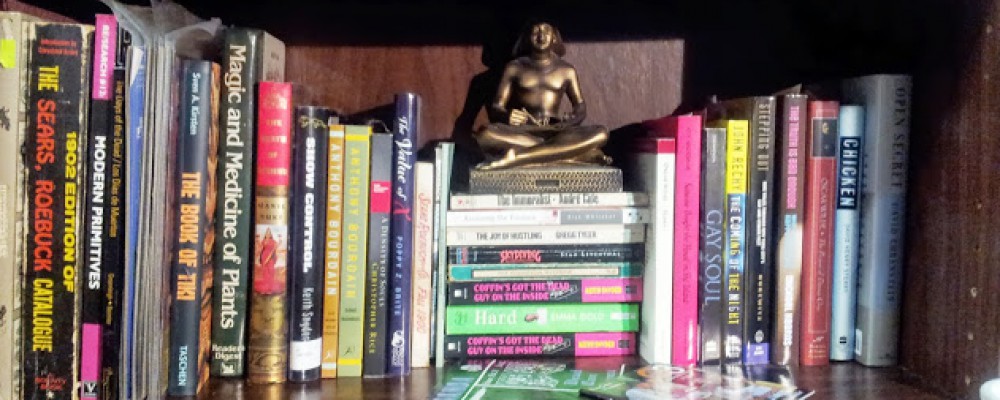“Secrets of the Gwangi” by Steve Berman from Second Thoughts: More Queer and Weird Stories (Lethe Press, 2008).
If you are surprised by this selection you are either a.) Not paying attention or b.) Not very observant. If it is the former, shame on you. How do you expect to ever be the latter? If the latter, I am sorry to be the one to point it out.
Old business:
- I should have reviewed this collection much earlier, preferably between reviews of the author’s first and third short story collections, but I skipped over it in order to review the third collection near its release date.
- I already reviewed the story that opens this volume. See Short Stories 365/77.
New business:
- I’m happy to report that artwork for the fourth collection recently appeared on social media.
And now, on to the story at hand…
This is a somewhat unconventionally-told short story. It makes great leaps from one time and place and set of characters to the next and back again. I’m tempted to say that like many of the stories in this volume it has a strong meta-fictive component as well, but here’s the thing: The more I get to know other writers and the more I compare back stories to bodies of work, the more I am reminded of a situation I found myself in a number of years ago. As you probably know by now, I worked in technical theatre for a couple of decades. You may also know there is a lot of down time to working backstage. It’s sort of like being on call, I guess. You spend long periods waiting for the show to start, or for paint to dry, or driving to the next venue.
It’s perfect for a writer, in other words. I used to carry a notebook with me, and there was a period of time in which one of the actors I worked with would, jokingly, come up and pester me, asking “What’cha writing? Is it about me? It is, isn’t it? C’mon, it’s about me, isn’t it? Huh? Huh? Huh?”
It always made me laugh. And, of course, I would protest that no, it was not about him. It also caused me to deeply ponder his question. The answer I came up with (but never said), was this: “No, it’s not about you. It’s about me. Every character I write is some aspect of me.” It’s interesting that I ran into this quote by Goethe on Twitter today: “Every author in some way portrays himself in his works, even if it be against his will.”
At the outset, this is the story of two cowboys, Tuck and T.J., who are hiding in a rock outcropping while some pterodactyl-type creatures feast on their horses.
Lovely image, isn’t it?
The next scene is set in the modern day. A man named Willis is in a bookstall, about to purchase the leather bound journal Tuck kept all during his and T.J.’s adventures. Willis thinks he’s just found the makings of the next Hollywood blockbuster, but the next scene, where he pitches his idea to a movie studio mogul, dashes his hopes. After that we see two boys, Chucky and Steve, sitting in a middle class living room, watching what purports to be the movie. They are maybe age twelve or thirteen, and Steve has recently realized he has feelings for Chucky. The final scene is between Esteban and Carlos, locals hired on during the filming of a movie. It might be a leap back in time to the making of the movie about Tuck and T.J., or it may be a different movie entirely.
The first, fourth and fifth situations are about couples, or would be couples. Tuck and T.J. and Esteban and Carlos are couples. Steve wishes he and Chucky were one, too. One of the middle sections re-writes the first scene and ignores the last two. Because Hollywood, as the kids say. Because greatest common denominator. Because dinosaurs, and I’m not talking about the pterodactyls.
This collection includes author’s notes, and the main thrust of those that accompany this story is that it’s based on something that happened to the author when he was twelve. Or thirteen. The back story has to do with roleplay gaming, so the note is prefaced by a chart entitled “Table 1-1 d8, Tale’s Veracity”.
Now, I was quite spoiled as a child. I was given pretty much anything I wanted, and so I had what I now know is “The Moldvay Basic Set”. D&D. 1981. Purplish box with a depiction of a dragon, a man with a lance, and a woman wielding an orb of green light.
What I didn’t have was anyone to explain what in the heck to do with the damned thing. My best friend and I looked over all of it, scratched our heads, and put it on a shelf.
Thankfully, I married well.
I rolled a five. Consulting the handy chart, we find this:
“Be suspicious of anything the author says.”
Really? Now tell me something I don’t already know.

